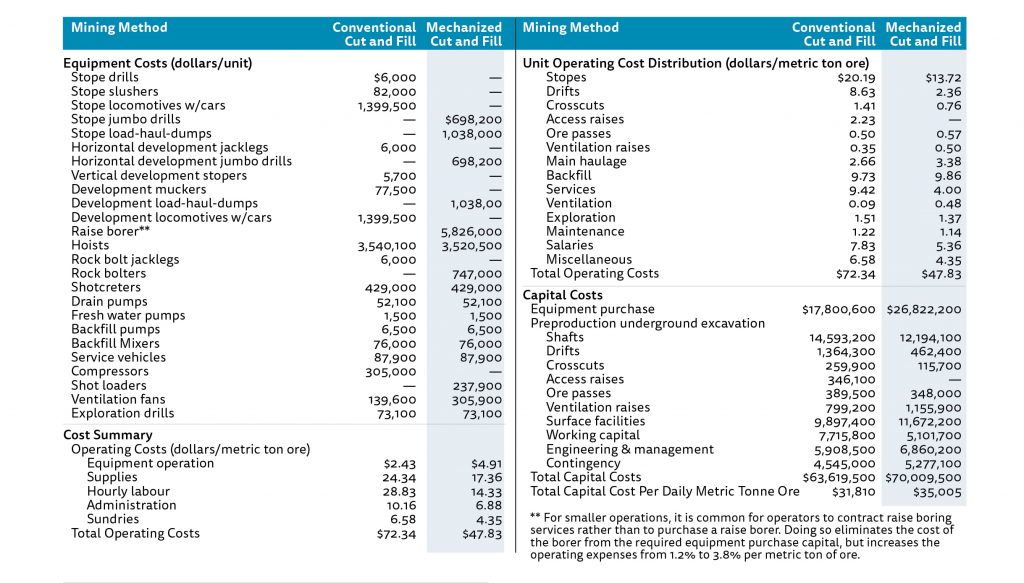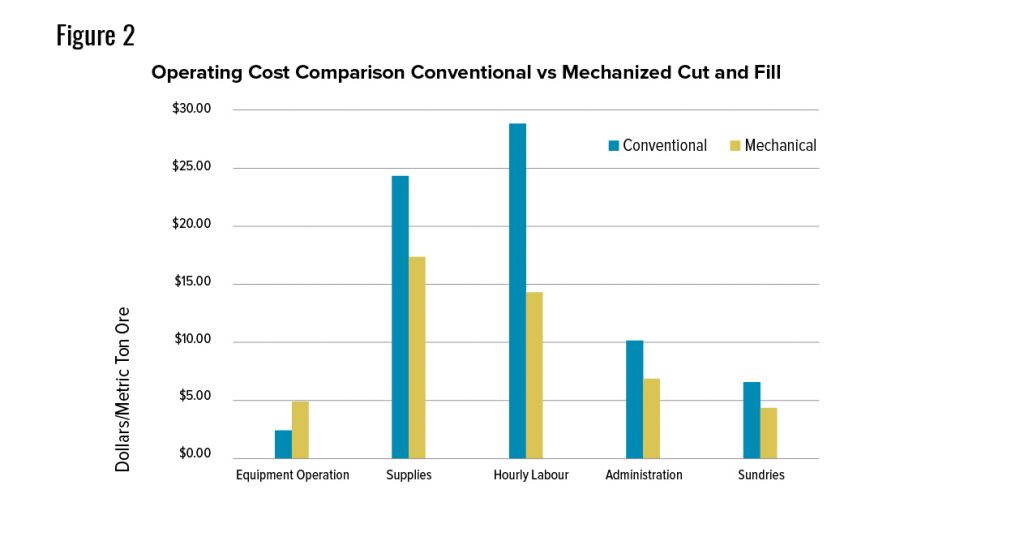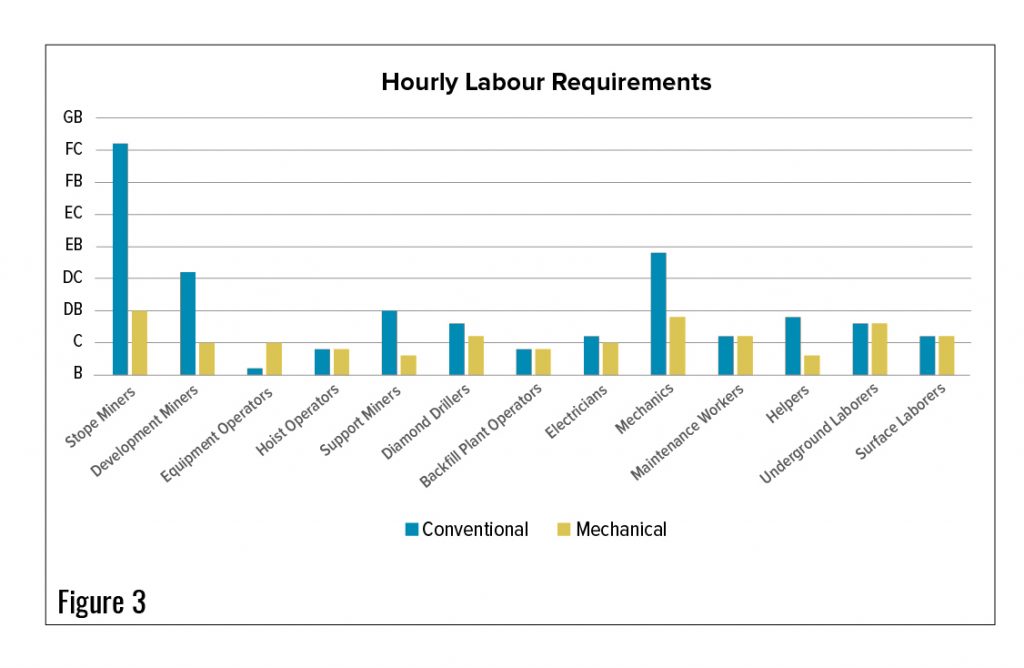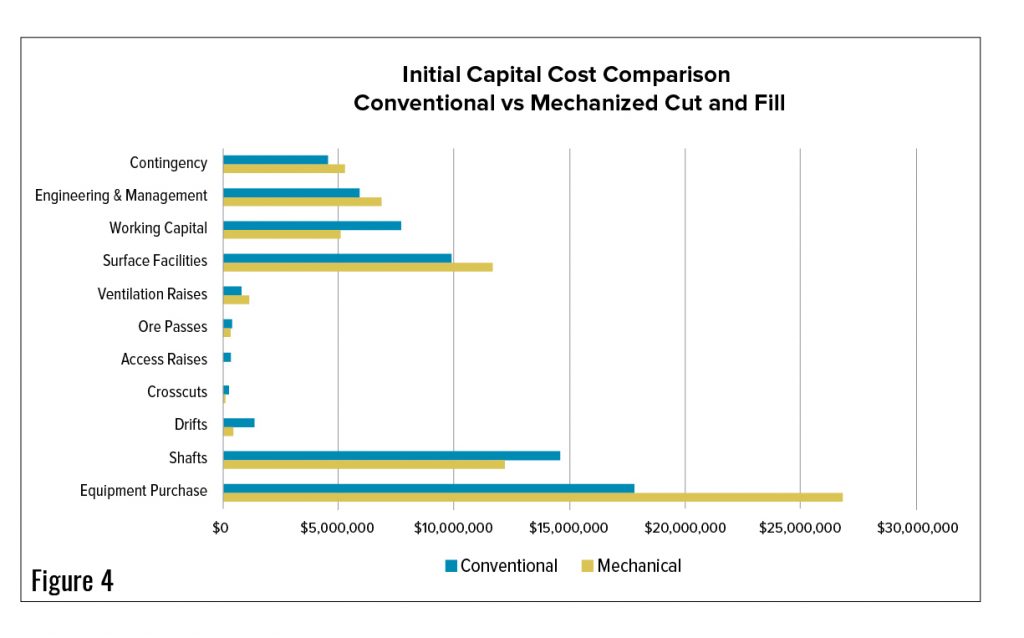Conventional versus mechanized cut and fill mining

Figure 1: Mechanized cut and fill example. Credit: CostMine
You have a mineral resource. It is tabular, narrow, steeply dipping, and of moderate to high grade. These characteristics lead you to select a cut-and-fill mining method, but which variant? More specifically, do you select conventional or mechanized? The answer to this question is dependent upon numerous factors, ranging from orebody geometry to safety. For the sake of completeness, we will briefly discuss many of these factors in this article, however, special focus will be given to mining costs.
A side-by-side comparison of two cost models will be presented, one conventional and one mechanized. We’ll touch on the pros and cons of each method to highlight the tradeoffs that mining engineers and managers must consider. The models presented have been drawn from the cost models section of Costmine’s Mining Cost Service.

Table : Cut and Fill Cost Model Comparison
 Cost Models
Cost Models
Prior to any comparison, it is appropriate to define the parameters for each model. The conventional cut-and-fill method presented below represents a mine with steeply dipping veins that are 3.5 metres in width and 1,900 metres along strike. Access to the mine is via an 863-metre shaft. Haulage to the shaft is via rail. Stoping includes drilling and blasting with jackleg drills, slushing to ore chutes and sand filling. A secondary access/vent raise extends to the surface. Production is assumed to be 2,000 t/d.
The mechanized model represents a mine with steeply dipping veins that are 4.5 metres in width and 1,900 metres along strike, with access to the mine via an 863-metre shaft. Haulage to the shaft is by scoop tram. Stoping includes drilling and blasting with jumbos, ore collection and haulage from the stopes by scoop tram and sand filling. A secondary access/vent raise extends to the surface. Production is assumed to be 2,000 t/d.
Considerations for the selection of cut-and-fill method
Geometry/Continuity – Vein geometry and continuity are very important in the selection process. The conventional approach is more suited to shallower vein angles and vein undulations, as it is more flexible than its mechanized counterpart. With its smaller openings and greater selectivity, it allows faster and easier stope adjustments, ensuring that miners stay on the vein and that grade control is maintained. Vein width plays a significant role here as well. Mechanized cut and fill generally requires slightly wider veins to accommodate jumbos and load-haul-dumps. As you see in our examples, the mechanized model works on the basis of a vein that is 1 metre wider than that for conventional cut and fill.
Grade – Ore grades must support the mining method. In this side-by-side comparison, one can imagine the scenario where narrow veins best suited for conventional cut and fill might be diluted if the mechanized approach is selected. Perhaps this is acceptable if grades are high enough. Conversely, even though wider veins may be mined with the mechanized approach, poor grade continuity might require the traditional approach.
Safety – With fewer workers at the working face and cab protections, the mechanized method improves worker safety. However, the conventional approach may be more attractive in poor ground conditions. This is due to the smaller openings and faster mining cycles that permit quick placement of backfill materials.
Development – Longer stopes and significantly more development are required for mechanized cut-and-fill mining, as multiple lateral ramps are required for the mobile fleet to access the orebody. However, more development does not translate to additional costs in most aspects of the design. Our models indicate that development costs for mechanized cut and fill are lower in four of the six main areas of consideration. Only ore passes and ventilation raises are more costly on a dollars/metre basis. Also, with regard to stope lengths, traditional cut-and-fill equipment is a limiting factor in capability and efficiency.
 Operating Costs – Operating costs for mechanized cut-and-fill mining are significantly lower in terms of dollars per tonne of ore. This is true for all operating costs other than those related to equipment operation (tires, fuel, lube, etc.) As Figure 2 illustrates, supplies and hourly labour are the biggest reasons for the operating cost discrepancies. More specifically, the higher daily consumption of rail and utility components (pipe, electric cable, etc.) for conventional cut and fill comprise the largest components of the supplies cost difference.
Operating Costs – Operating costs for mechanized cut-and-fill mining are significantly lower in terms of dollars per tonne of ore. This is true for all operating costs other than those related to equipment operation (tires, fuel, lube, etc.) As Figure 2 illustrates, supplies and hourly labour are the biggest reasons for the operating cost discrepancies. More specifically, the higher daily consumption of rail and utility components (pipe, electric cable, etc.) for conventional cut and fill comprise the largest components of the supplies cost difference.

 Labour – Fewer workers are required for mechanized mining, leading to improved safety and lower operating costs. Figure 3 illustrates the breakdown of workers. Note that stope, development, and support miners, along with mechanics, make up the bulk of the reduction in workforce under the mechanized option.
Labour – Fewer workers are required for mechanized mining, leading to improved safety and lower operating costs. Figure 3 illustrates the breakdown of workers. Note that stope, development, and support miners, along with mechanics, make up the bulk of the reduction in workforce under the mechanized option.
Capital Costs – Initial capital costs are higher for mechanized cut and fill due primarily to the required mobile fleet purchase. These higher capital costs are offset to some degree by lower operating costs over time. Conversely, conventional cut-and-fill mining requires a lower capital outlay at the onset, but the operating costs are substantially greater over time, in particular labour costs (see Figure 4).
Discussion
The observations above elicit several questions that must be considered when developing a new mine via cut-and-fill methods.
From the capital and operating cost perspectives, these questions may include:
• Over time, will my operating expenses make up for the initial capital outlay if the mechanized method is selected?
• What are the long-term, life-of-mine tax implications at my operation if I choose one method over another?
Non-cost-related questions may include:
• What workforce is available in my area?
• Which extraction method is better suited to the orebody in terms of geometry, grade, and integrity?
These simple questions do not always have simple, clear-cut answers, and tradeoff studies will be required. Our advice is to carry out your mine, cost, and economic analysis early… and often.
Brad Terhune is a cost analyst and senior geologist with Costmine (www.costmine.com), part of the Glacier Resource Innovation Group, based in Spokane, Wash. He can be reached at bterhune@glacierrig.com or 509-328-8023.
Comments
Edwin Gañan
Fantástic